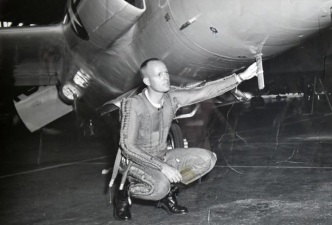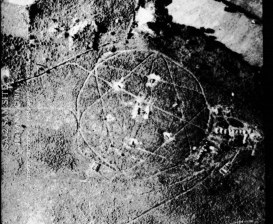

Yet another book has been published on the Cuba Missile Crisis, this one with significant U-2 content. And one particular focus for the “best-selling” authors of “Above & Beyond”, is the missions flown by SAC pilots Rudy Anderson and Chuck Maultsby on ‘Black Saturday’, 27th October 1962. That was the day that Maultsby accidentally strayed into Soviet airspace while on a nuclear test fallout sampling mission in the Arctic, and Anderson was shot down and killed over Cuba.
Unfortunately, in an attempt to persuade readers that they have uncovered a new mystery, Casey Sherman and Michael Tougias rely heavily on the recollections of one man. This is Jerry McIlmoyle (above left, as a young U-2 pilot). He claims that he was attacked by Soviet SA-2 missiles (above right, one of the sites in Cuba) two days before Anderson was attacked. Sherman and Tougias support McIlmoyle’s controversial contention that the incident was suppressed by his military superiors to suit their own agendas eg to keep the U-2s flying over Cuba. But there is now substantial evidence to suggest that McIlmoyle was mistaken about the attack.
Confession: when I wrote 50 YEARS OF THE U-2 in 2005, I included Jerry’s claim of a missile attack without any reservations (page 174). He was, after all, a retired Brigadier-General, and I had met him twice at reunions of the SAC U-2 wing and heard his story. He subsequently repeated the claim to me in emails.
Since 2005 however, significant new information has emerged on the status and actions of the Soviet-operated air defense system in Cuba in October 1962. Some of it comes from declassified US documents, and some of it from Russian accounts.
McIlmoyle claims that he was attacked on 25th October by the same SA-2 site at Banes in eastern Cuba that shot down Anderson on the 27th. But an official USAF account of SAC operations during the Crisis (SAC Historical Study No 90 Vol 1 page 214) states that McIlmoyle’s mission was routed over northwest Cuba. That is about 400 miles from Banes. (Incidentally, all of McIlmoyle’s targets were cloud-covered, and these weather conditions also forced cancellation of the three U-2 missions planned for the next day).
On the day of McIlmoyle’s flight, the CIA assessed in a document declassified in 1998 that all 24 identified SA-2 sites in Cuba “now are operational, although there is still no evidence of an integrated command and control system.” That situation did not change until the day after McIlmoyle’s flight, according to the CIA, when intercepted signals indicated “a step towards integration.”
Of further note, various documents from the National Security Agency (NSA) declassified more recently state that, apart from some earlier short-lived test transmissions, the SA-2 radars throughout Cuba were not turned on until the early hours of the 27th, two days after McIlmoyle’s flight. This intelligence came first from the NSA’s SIGINT-gathering spyship USS Oxford, sailing off the Cuban coast. The full activation of the SA-2 air defense system on the 27th was confirmed within a few hours by SAC’s SIGINT-gathering RB-47H Stratojets.
Neither the USS Oxford nor the RB-47Hs had previously detected such an activation. The long delay in bringing the SAM system to full operational status – the first photographic evidence of SA-2 missiles on Cuba was obtained by a CIA U-2 mission on 29th August – was confirmed by the memoirs and interviews of Soviet participants in the Crisis that were quoted in detail by Michael Dobbs in his 2008 book “One Minute To Midnight”.
Sherman and Tougias make use of these sources elsewhere in their book. Did they not wonder why the Soviet accounts make no mention of the attack on McIlmoyle’s flight? Indeed they themselves tell us on page 248 of their book that when two Soviet generals on Cuba gave the order to shoot down Anderson on the 27th, they had previously “repeatedly asked Moscow for permission to shoot down spy planes but had not received the go-ahead.”
McIlmoyle also says that the lights in his cockpit that were supposed to warn him of a SAM attack did not come on. Sherman and Tougias speculate that this was because the missiles “might have been launched without full radar capacity.” (pages 231-2)
But there were no such lights at that time: declassified CIA documents and my own research interviews confirm that the new System 12 device which warned of a SAM attack, was not installed in the CIA’s U-2s until November, and not in SAC’s U-2s until January 1963 (50 YEARS OF THE U-2, p183-4). Although he was a SAC pilot, McIlmoyle was flying a CIA U-2 on 25th October. However, I suspect that he was remembering instead, the System 9 lights which warned of an intercepting fighter attack. That system was already installed in the CIA’s U-2s.
According to McIlmoyle, he duly reported the SAM attack at his postflight debriefing. The following morning, he says, a three-star general flew into McCoy AFB from Washington DC specifically to tell him that he had not been shot at. McIlmoyle has not specified who this general was, and there is no record of the visit in the SAC U-2 wing’s history for October 1962.
Years later, when McIlmoyle had become a one-star general and was serving in Washington, he says that he was able to get confirmation from the CIA that the photo-interpreters that examined the tracker camera film from his 25th October mission believed that he had indeed been attacked by SA-2 missiles. (The 70mm tracker camera was designed to provide a wide view of the terrain below, to aid in locating the targets photographed by the main U-2 ‘B’ camera, which offered much higher resolution but of smaller areas. Because of the cloud cover on this mission, the main camera film was either not exposed, or not archived).
Could it be, however, that the attack on McIlmoyle’s U-2 was by a MiG-21? That interceptor would have been contrailing, and thus might have been mistaken by the pilot for the trail left by an ascending SA-2 missile, especially if the MiG was zoom-climbing.
Whatever the case, authors Sherman and Tougias should have been aware of the doubt surrounding McIlmoyle’s claim, and should certainly not have used this single source to construct a questionable conspiracy theory about the reactions of his higher commanders.
Ironically, while the declassified NSA documents mentioned above cast doubt on the supposed SAM attack on the 25th, they do still highlight an intelligence failure.
On the 27th, Rudy Anderson should have been warned about the activation of the SAM system some hours earlier, and his flight cancelled or re-routed, before he was sent on a mission that took him within the effective range of SA-2 sites. But no warning ever reached the U-2 detachment at McCoy AFB.
This failure is discussed in detail by electronic warfare veteran Wayne Whitten in his book “Without A Warning”, published in 2017 and available via Amazon. I helped Wayne with his research, and wrote the Foreword to that book.
Sherman and Tougias deal extensively with the politics of the Crisis, like so many authors before them. I am not qualified to criticize their account of the deliberations in the White House, nor their description of President Kennedy, with its emphasis on his medical condition. But I hope they do not contain the inaccuracies that are so evident in their first section, which is on Chuck Maultsby’s U-2 experiences.
This is a description of his flight training (pages 72-79), which says that Maultsby accomplished it at the super-secret Groom Lake airbase in Nevada. How could the authors make such an error, when Maultsby’s own memoir – which they cite – makes it perfectly clear that he was trained on the U-2 at SAC’s Laughlin AFB in 1961? No U-2 pilot was trained at Groom Lake after May 1957.
As for Maultsby’s excursion into Soviet territory on ‘Black Saturday’, the authors have nothing new to add to previous comprehensive published accounts, including my own and that of the U-2 pilot himself.
To sum up: this book adds little to our knowledge of the U-2 in the Cuba Missile Crisis, and makes one questionable assumption. It’s true that Sherman and Tougias do provide some worthwhile human-interest background on the private lives and characters of Anderson, Maultsby and other U-2 pilots. But they make multiple mistakes that could have been avoided if they had read 50 YEARS OF THE U-2. I counted thirty more errors of detailed facts!
Anderson family kicked off Laughlin AFB totally untrue as verified by personal conversation with surviving Flight Surgeon who attended Mrs. Anderson ! James S. Long, LHF, Inc.
LikeLike